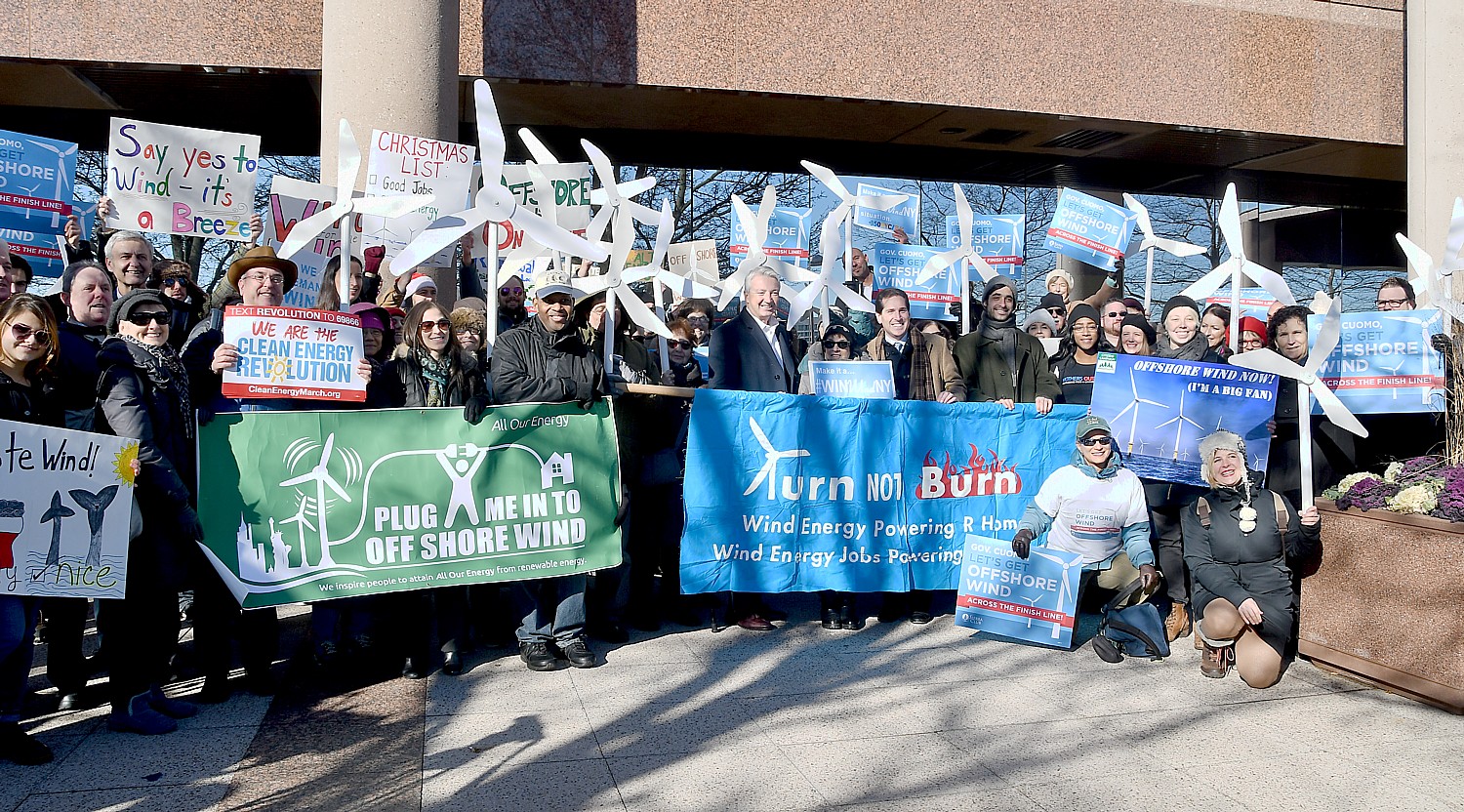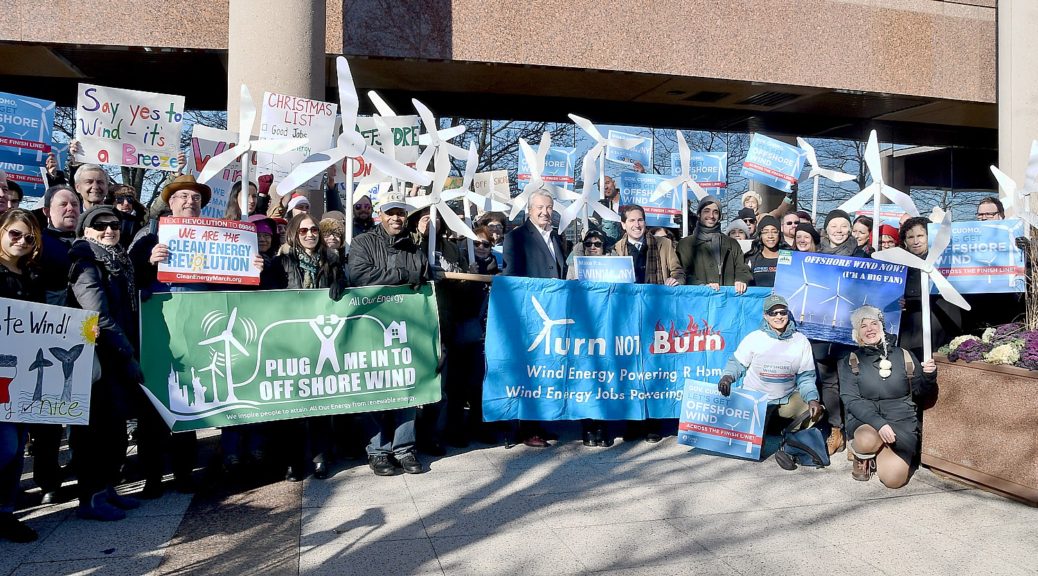
By Karen Rubin, News & Photo Features
Governor Andrew Cuomo sees the opportunity to create a new industry centered largely on Long Island to take advantage of the offshore windpower in an area of the Atlantic Ocean, considered “the Saudi Arabia of windpower.” In this, the state is acting much like other nations which jumpstart new industries by funding critical studies, research centers, workforce development. This is all to ease the way, lessen the risk and increase likelihood of success for the private companies which are expected to vie for leases from the federal Bureau of Ocean Energy Management (BOEM).
Cuomo has set a standard of the state generating 50% of its energy needs through renewable by 2030, and offshore wind, in addition to solar, hilltop windpower, hydroelectric and other sources (“all of the above”) are considered essential to meeting that goal, which Cuomo has proudly declared the most ambitious in the nation.
The New York State Department of Environmental Conservation just released proposed regulations to require all power plants in New York to meet new emissions limits for carbon dioxide (CO2), a potent greenhouse gas that contributes to climate change. The regulations, a first in the nation approach to regulating carbon emissions, will achieve the Governor’s goal to end the use of coal in New York State power plants by 2020.
Environmental groups including Sierra Club have long advocated offshore wind, especially as Long Island faces a crucial transition juncture of expanding or upgrading fossil-fuel based power plants to meet its energy needs, versus investing and transitioning to renewable energy.
The state is targeting acquiring 2,400 megawatts of energy from offshore wind – the equivalent of what is generated by the Indian Point Nuclear Power Plant – enough to power 1.2 million households. The associated industries that would develop to manufacture the wind turbines and platforms, construct ports and stage the equipment, install the turbines, operate and maintain the systems are expected to employ some 5,000 people in relatively high-paying jobs, and generate $6 billion for the region. What is more, over time, windpower will bring down the cost of electricity on Long Island, where high costs of energy are considered impediments to economic growth.
At the same time, the state has invested in new research programs at State Universities, including Stony Brook to address key issues such as storage batteries (for when the wind does not blow), and transmission.
The master plan, being unveiled in public hearings, has been developed over a period of years by New York State Energy Research and Development Authority (NYSERDA).
The strategy is to be the furthest along in order to be first in line to contract for the electricity, which could be sold to New Jersey and other regions, to reduce cost and risk to private entities which will bid for the rights to construct and operate the wind turbines. The state is not actually seeking to be the winning bidder for the leases, but to be the customer for the power for those that do. And the state is also aware that other customers – New Jersey, as one example (though the former governor Chris Christie showed little interest, the new governor Phil Murphy is) – will also be bidding. But there is great confidence because of proximity and the sheer market size, that New York City and Long Island residents will be the beneficiary. And there is so much energy potential from this area, there is “enough for all.” Indeed, NYSERDA is eyeing 3,200 MW of production from the sites it has targeted, of which it would contract for 2,400.
NYSERDA has conducted studies in 20 areas –literally every environmental, biologic, economic and engineering aspect – in order to define every aspect of locating the best places to position turbines and cables, where to stage construction, where to manufacture the turbines and components, even where to invest in workforce development. All along the way, the agency has engaged stakeholders – from municipalities and environmentalists to labor unions to consumer advocates, to commercial fishing interests.
The state has allocated $15 million to spend on workforce development and infrastructure advancement (for example, building port facilities), and is allocating up to $5 million for multi-year research studies that will assist project developers with the data will be made available by NYSERDA in real time to public. For example, data on wind speeds particularly impact economics of projects and will improve the certainty of bids to state.
“We are seeking to invest $20 million or more, kicking off in 2018, for research and development – component design, systems design, operational controls, monitoring systems, manufacturing processes,” said Doreen Harris, Director, Large Scale Renewables, NYSERDA.
To attract private investment in port infrastructure and manufacturing, the state is hoping to spotlight promising infrastructure investments (60 sites have been identified), helping jumpstart project development and “secure its status as the undisputed home for the emerging offshore wind industry in the US.”
Think of it: Long Island used to be the center for America’s aerospace industry. Now it can be a leader in a global offshore windpower industry. What is more, off shore windpower can also bring down Long Island’s historically high utility rates which are considered an impediment to business development and economic growth.
“We’ve established technical working groups to determine best use of funds – to insure new Yorkers well prepared to serve offshore wind industry and connected to the global Industry.” Indeed, offshore wind is brand new for the US, but has been in force in Europe for 25 years.
The United States projects will have the benefit of leap-frogging over earlier technology, with more efficient, productive, and less environmentally risky structures.
The state is estimating that the near-term incremental program cost would be less than 30 cents a month for a typical homeowner – the cost of windpower is front-loaded in the initial construction, as opposed to fossil-fuel generated energy which continues to get more expensive over time because it is a finite resource that is increasingly more difficult and costly to obtain and needs to be transported from further distances to users. Electricity generated from wind is already competitive with fossil-fuel generated power, but over time, as usage thresholds and technology improvements are reached, the costs will go down. And this does not even factor in the environmental and public health benefits of transitioning from carbon-based fuel.
The only kicker is that while New York State is being pro-active, it is BOEM that ultimately controls the leases and is undertaking similar studies, so people are concerned this can be unnecessarily time-consuming and duplicative. And while BOEM under the Obama Administration was full-speed ahead and keen to develop offshore windpower, concern was raised after Interior Secretary Ryan Zinke declared the entire continental shelf open for drilling, and this prime windpower area used instead for drilling rigs or equally horrible Liquified Natural Gas (LNG) terminals such as the Port Ambrose that had been beaten back by Governor Cuomo.
But BOEM’s Energy Program Specialist Luke Feinberg, who attended NYSERDA’s May 8 public hearing in Melville expressed enthusiasm for offshore wind in this area (not to mention the area does not seem to have much potential for oil). BOEM presented a timetable that projects out two to five years before actual construction can begin; BOEM intends to hold its next lease auction no later than 2019.
BOEM is taking comments on the proposed “New York Bight” Call Area by May 29. Submit comments and view documents at boem.gov/New-York/
The New York Public Service Commission is now considering a number of options for the state to advance solicitations once the leases are awarded; send comments or view materials at http://documents.dps.ny.gov.
To get more information on the New York State Offshore Wind Master Plan visit nyserda.ny.gov/offshorewind.
_____________________________
© 2018 News & Photo Features Syndicate, a division of Workstyles, Inc. All rights reserved. For editorial feature and photo information, go to www.news-photos-features.com, email editor@news-photos-features.com. Blogging at www.dailykos.com/blogs/NewsPhotosFeatures. ‘Like’ us on facebook.com/NewsPhotoFeatures, Tweet @KarenBRubin

